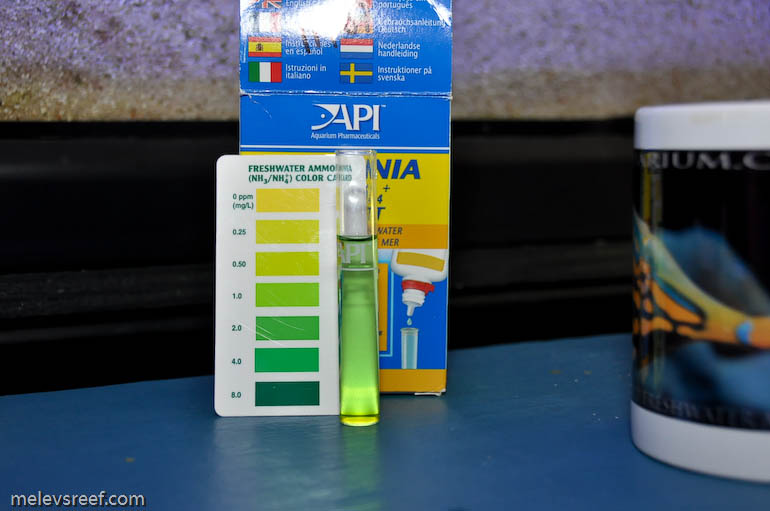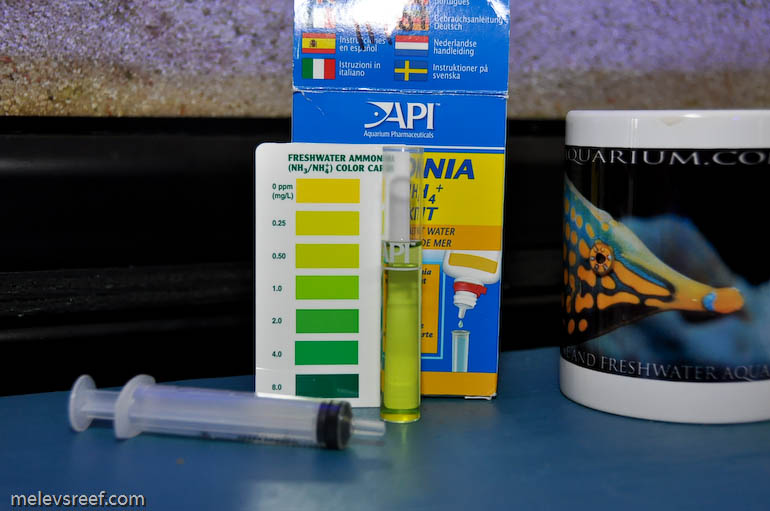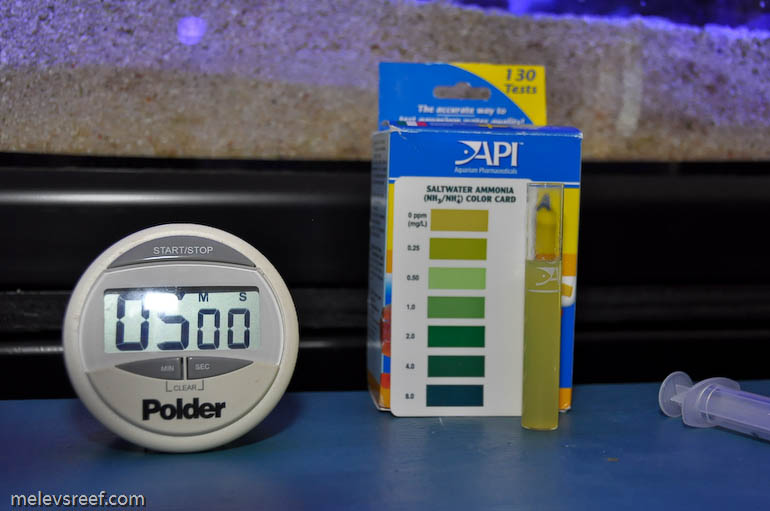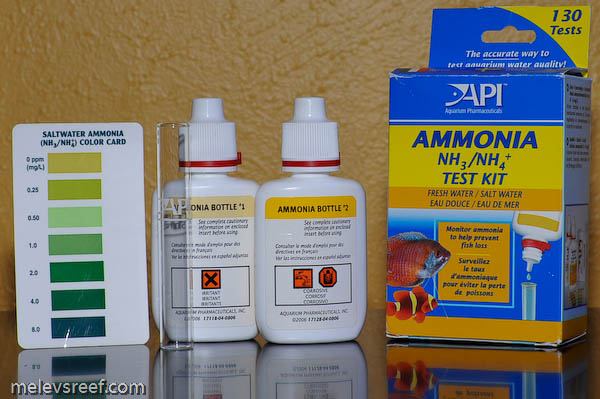Heads up, everyone. Your livestock could be at risk. This is no joke; a few nice tanks full of corals have suffered from the additives cities are dumping into our drinking water to make it safer for human consumption.Our bodies are able to deal with this stuff usually, but our livestock is far more demanding by comparison.
Something we rarely test is ammonia, a test kit relegated to back of your closet after the tank’s cycle has completed. Fish start to die, and we retrieve it. But when your fish are fine and corals are declining, you often check alkalinity & pH levels, as well as salinity. I’m recommending you find your ammonia test kit TODAY, and immediately start testing your waters: tap water, RO water, DI water, and newly mixed saltwater. If you discover ammonia in the top off water, do you know what to do?
API’s ammonia test kit works for fresh water and saltwater, and is affordable at $10. When I recently heard from a club member that his corals were dying, we discussed his water conditions. We had much in common: same RO/DI system, same city water source, same volume of water in our systems. Frustrated, he added additional stages to his RO system to help take out chlorine and ammonia to make the water safe for his livestock. I decided I better test my water as well, if nothing else than to rule out that this wasn’t an isolated case.
Collecting a small sample of tap water after letting the faucet run for 30 seconds, the kit indicated 1ppm ammonia.

Next I tested the water coming out of the 150gpd membrane of my RO system: .5ppm My next test was after the DI section, which also was .5ppm instead of zero. Ammonia can pass right through DI resin if the level is high.

Every drop of top off water was adding ammonia to my tank if left unchecked. My system needs 3.6 gallons of top off daily to replace evaporation, so ammonia at this level wouldn’t be toxic, but it begs the question: when it is too much? What about those that rely upon evaporation to cool their tanks using huge fans? How much toxic top off water are they adding?
Rather than risk hitting that tipping point, I immediately dosed my top off water with Seachem’s Prime, and lowered a sterilized powerhead into the 45g reservoir for 9 minutes to make sure the dechlorinator was thoroughly mixed in.
Once that was done, I tested my reef’s water, and was happy to read that it measured 0. Whew, caught it in time.

Since discovering this situation, I called my local fish store to warn the store owner that the water he was selling was likely at risk since he’s within walking distance of my home. He opted to add some Prime to his water for the time being to make sure his customers are well cared for. Two more friends reported sudden coral losses, and were advised to test for ammonia immediately. Both of these individuals were doing water changes trying to fix the situation, which only made things worse with the rising ammonia levels.
I don’t know if this is a nationwide issue, but for those suffering drought conditions due to the dryer summer months, the fact is that water tables become increasingly contaminated due to the dwindling water supply. Those of you with tons of rain may experience changes as well. I’m imploring you to do all the tests and don’t assume your locale is immune. Better to know for a fact and continue to enjoy your aquarium rather than assume all is well and find yourself struggling to correct a crashing system.
If you discover you have trace levels of ammonia or chlorine, Seachem’s Prime is the perfect product to lock it up in both top off and newly mixed saltwater. For years I’ve recommended every hobbyist keep a bottle in their arsenal for emergencies and this is definitely one of those times. I don’t know its shelf life, but I always buy a brand new bottle annually. One capful treats 50 gallons, making it quite economical. It is safe with your livestock. Here’s the official link: http://www.seachem.com/Products/product_pages/Prime.html
For the time being, I’m going to be adding Prime to all the water going into my tank until conditions improve.
Feel free to share your results, either to forewarn or to assure others what the current conditions are in your area. Be proactive and talk with your club members to make sure they are aware of this possible risk. Do it now, the reef you save may be your own!











Marc, if you’re adding topoff water with those low amounts of ammonia present, my take on it is, it’s no different than having a tiny increase in bioload in your system. Your biological colonies would compensate for the added ammonia and process it the same way it would for another fish in your tank.
NOTE: I’m NOT advocating knowingly adding ammonia to any system. I just don’t see it being as bad as you’re making it out to be…..in an established, healthy system. The continuous addition of a constant .5ppm in 3.5g of water daily is no different than another critter in your tank adding waste.
That point is well taken, but I prefer to avoid adding that at all. The thing is, others are dealing with higher levels and when doing bigger water changes “to fix the problem” they are adding considerable amounts of ammonia with each change. Picture doing three or four big water changes in a week’s time. Now it is definitely a compiling issue.
Everyone needs to take the time to find out for themselves what their situation demands, and adjust their husbandry accordingly.
Great to hear from you masterswimmer. It’s been a while. 😉
Always a pleasure Marc.
I can see how excessive water changes meant to correct what’s thought to possibly be a different problem would only exacerbate an unknown ammonia problem. So knowledge is the key (as always), and passing on new found information about ‘environmental’ factors (or human imposed 😉 ) can only help hobbyists trying to identify the source of mysterious ailments.
Normal daily topoff shouldn’t effect a healthy system at all, IMO.
Russ
Unless…. lol…. they are topping off in larger amounts due to evaporative cooling with fans like me instead of using a chiller. This in turn uses more top off water per day. Couple that with the chance that the ammonia level is higher than your comment above, say 1ppm. Now it actually can be problematic.
Clearly we do agree that the most important part is being informed. Once you know what’s going on, you can adapt more readily. 🙂